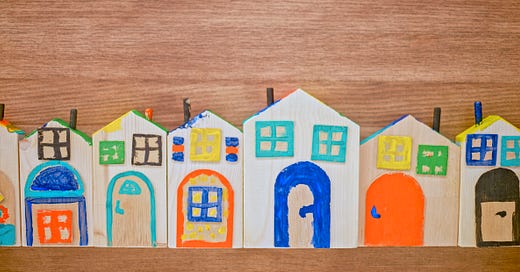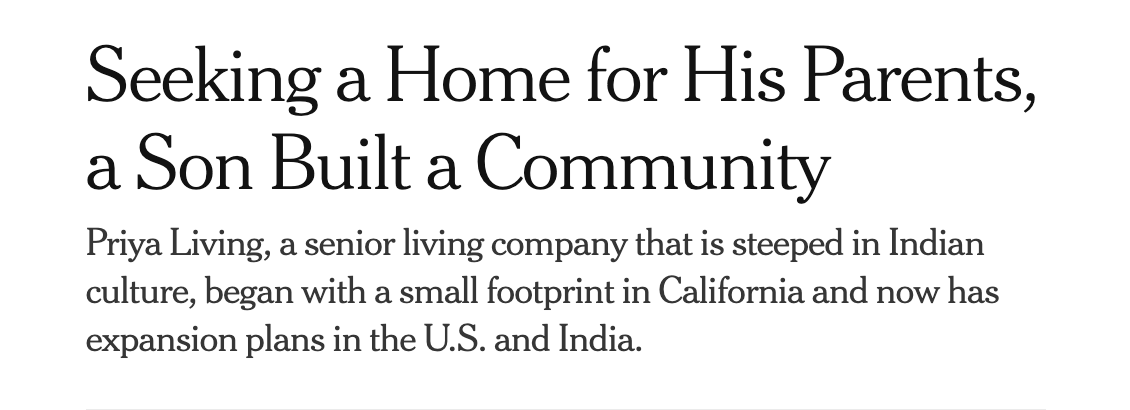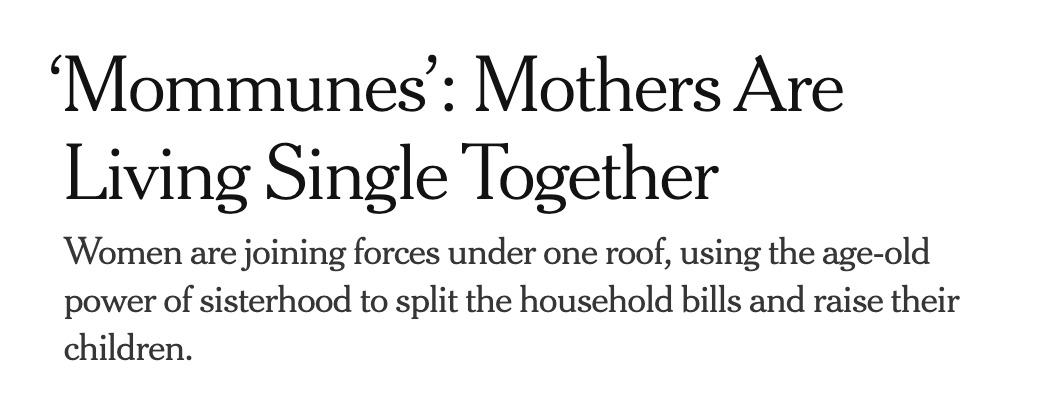
You know how I know people are desperate for a new way of organizing their lives? Apart from just selling a book about it? Well, the New York Times keeps reporting on it. Let’s take a look at what they’ve found (and I’ve gift linked all of these, so click away).
First, there’s the “Senior Living, Not Just For Seniors” scenario:
The Thesis: Senior living communities are, well, communities. They’re imminently walkable, they usually have great quasi-public transport options, they’re overflowing with scheduled activities and opportunities for the formation of strong and loose ties. As we discussed in The Friendship Dip, some of this works because 1) boomers are just generally better at community and 2) retirees have a whole lot more time for it.
The article points out that retirement community housing is generally more affordable (the constricted buying pool keeps prices down). Plus, as evidenced by the story of the 59-year-old who moved in and now spends a solid hour a day in swim team practice, it can be a real source of energy and inter-generational friendship. So why wait until you’re retired to have some aspects of the retired lifestyle?
The protagonists of this story moved to this particular retirement community in Florida during the pandemic, and there’s a strong subtext (maybe not so sub) that they thought the Covid restrictions in their home state of Pennsylvania were too strict (“militant lockdown”) and welcomed the more….casual approach in Florida. Are they Trump supporters? Probably! Are most retirement communities filled with Trump supporters and thus hostile to a lot of people who might otherwise enjoy what they have to offer? Yes, absolutely! (The Villages — famously the largest retirement community in the United States — is 96.8 percent non-Latino white, and 69% of its residents voted for Trump in 2016).
But retirement living doesn’t have to look like The Villages. Consider Priya Living, which caters specifically to Indian-Americans.
The Thesis: Many aging Indian-Americans moved to the United States decades ago for education and/or careers, leaving behind tight communities back home. As they age and retire, living with family isn’t always the right fit. But they also don’t want to live alone. When Arun Paul started looking for a duplex for his parents to live with their close friends, a bunch of their other friends started calling him, asking to be included. So he built a 26-unit community “steeped in Indian culture” and then built three more — all in California.
You don’t have to be Indian or retired to live there, but the majority are both. The average age is 65, but there are residents as young as 35. There are Bollywood film screenings, tea and gossip sessions, celebrations for Indian Holidays, and all the smells of home. “There are people from all parts of India here — from Hyderabad, Karnataka, Punjab, Kerala, Tamil Nadu, Bengal, Rajasthan,” one resident told the Times. “Every home has its own way of cooking or spices. So when you’re walking around here, you sense the different aromas, you come home feeling hungry.”
That same resident — Geetha Iyengar, age 78, whose husband died several years ago — admitted that sometimes there are small annoyances, and you have to figure out how to live differently with other people. But that’s part of the promise of living in community: the connections are ultimately worth the compromises.
Okay but what if you have kids? And are single-parenting? How about a Mommune.
The Thesis: Nearly 80% of single-parent households in the United States are headed by women. Being a single adult is incredibly expensive and being a single parent is even more so. Living together allows single parents to share caregiving responsibilities and foster economic mobility (which is often elusive in one-parent households).
The article is quick to point out that non-white mothers have been living this way for a long time — Grace Bastidas, editor-in-chief of Parents.com, grew up in a Mommune before Mommunes were cool or even called mommunes. Her mother and her aunt — both unmarried — lived together and raised her, her sister, and her cousin. She thinks that people (and white women in particular) are finally giving up the ghost of white-knuckling solo living no matter the cost. If we agree it takes a village to raise a child, in other words, why not actually create the damn village?
I especially appreciated this quote from clinical psychologist Naomi Torres-Mackie, who told the Times that single motherhood can lead to “role strain” — aka, what happens when you’re acting as both parents and an employee and a friend and a sibling and a daughter etc. et. al. “Sharing resources is key,” she said, “and can be an antidote to not just role strain, but social isolation and stigma.”
One of the featured mommunes is basically just two professors co-living with their teens in Abu Dhabi. There’s also Carmel Boss, who founded a non-profit-turned-for-profit years ago called CoAbode that helps match single moms looking for co-living situations. My personal favorite is the pair of newly divorced longtime friends who found a four-plex and rented out the other two units. (Somewhat hilariously, their first tenants fell and love (with each other) and moved out).
“In the patriarchal, heteronormative story, you get divorced and stay in the house, or you buy another home, and you live this isolated life where you’re supposed to date and fall in love again and get remarried or blend families,” one of those moms, Herrin Hopper, said. “It seems like it’s always a binary, and we have dispelled this myth that there’s only one path forward.”
Okay but what if you don’t have kids and maybe don’t plan to? Buy a house with friends.
The Thesis: The housing market is wild, particularly in high-demand urban areas like New York City. The competition for anything under $1 million is particularly stiff. Why not pool your resources with friends and buy a multi-family house? That’s what these three friends did in Brooklyn and this couple and their good friend did in Queens (“Ben is our couple friend,” said Ms. Russo, a media producer. “Couples have couple friends, and our couple friend just happens to be Ben.”)
New York is particularly well-suited to these sorts of searches: the city is filled with multi-family dwellings. Some people somehow manage to buy one and then rent out the other floors, but for many buyers, that sort of up-front down payment is out of reach (particularly with interest rates where they are now). Put together your savings with friends and your options expand significantly — and you get to live with your friends! In both of these cases, the three parties assembled legal contracts to cover various crappy scenarios and agreed to shared terms (no Airbnb’ing; if they need to suddenly sublet, the other residents get a say on the sub-letter, etc.).
It’s messier than, say, buying a place on your own. But you get the sort of outdoor space that’s highly coveted in New York. And did I mention that you get to live right next door to people you actually like, people who can help you in a pinch, people who (as one resident notes) can help you pick out your outfit? BUT YOU ALSO HAVE YOUR PRIVATE SPACE? You can see the appeal.
Okay but what if you don’t want to buy a place? How about the 21st century version of a boarding house.
The Thesis: New York is currently filled with under-used office space. For various complicated reasons, those office buildings are very difficult to convert into apartments. But “flexible co-living,” aka a big adult dorm? Maybe the millions of residents spending way too much on rent and hungry for some sort of community will go for it.
When experts talk about housing shortages, they often note just how many essential types of housing — housing that plugged holes and served very specific purposes — have effectively been eliminated from the market. And none gets cited more than the boarding house, where people rented a single or shared room for indeterminate periods (and usually also received breakfast and dinner). If you’ve read any piece of literature set before, oh, World War II, you’ve likely read a plot line involving a boarding house. Today, Airbnbs and short and extended-stay hotels and motels serve some of this function, but it’s not really the same.
And, to be clear, these “flexible co-living” spaces aren’t really the same either — there’s no headmistress matron figure scooping soup into your bowl, just to start. But they nevertheless offer a viable solution for a significant housing problem.
What you see above is the Times’ story of what co-living (and its connection to community-building) looks like in 2023. Significantly, all of these stories are from the Real Estate section (save the last one, which is a real estate story packaged for the morning newsletter). This placement makes sense for two reasons: 1) housing is the #1 obstacle people cite when telling me why community isn’t /hasn’t worked for them; and 2) Americans are conditioned to think of “shopping” (aka, buying things) as the most efficient way to solve a problem.
Put differently best solution to the overarching problem of loneliness and the desire for more community and mutual care is to…..buy a (different) house. A very New York Times solution! To be fair, sometimes buying a different house really does solve some of these problems — particularly if you’re interested in trading what people usually look for in a house (space, more space, and amenities that match your specific tastes and preferences) with the characteristics that actually help build community (shared living spaces, shared caregiving responsibilities, smaller overall footprints).
My first inclination (and maybe yours, too) is to critique this sort of real-estate-forward solution. Private property — at least as we’ve currently arranged it — is an engine for inequality; our hunger for it has made us worse stewards of the world and less responsible to one another. (For much more on this idea, please check out Antonia Malchik’s newsletter On the Commons)
But I want to hold that critique alongside the pressing, irrepressible hunger for community and intimacy — the sort that feels impossible unless something changes with where and how you live. For what it’s worth, I see that hunger most pronounced in people with solid incomes, often married, generally but not always with kids, and deep in the friendship dip. They are financially capable of these sorts of changes but extremely reticent to make them. It’s hard to turn away from a status quo you worked so hard to achieve, even when you realize it’s making your daily life pretty miserable.
So for our discussion today, I want to invite us to think about imaginging a different status quo — a different aspirational peak. Consider what you find appealing and unappealing about the options above…..and take a look at the various and frankly very exciting co-living case studies the newsletter Supernuclear is collecting (I’m particularly interested in what’s happening with Radish)
We’ve previously talked at length about roadblocks to making this sort of thing happen, and those all matter. But for today, I want to think seriously about these alternatives.
What sounds amazing? What’s a deal-breaker and why? If you were designing your own co-living scenario, what would it look like? Be detailed!! And finally: when I interview one of the co-founders of Supernuclear about their work in shifting our thinking on just how many ways you can live in community, what do you want to know more about?









